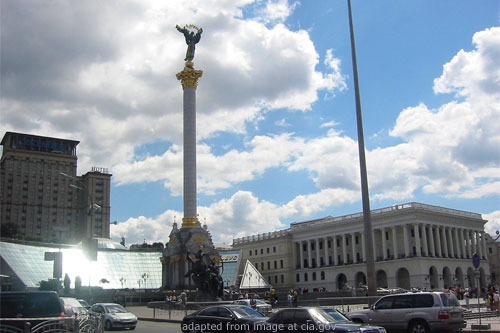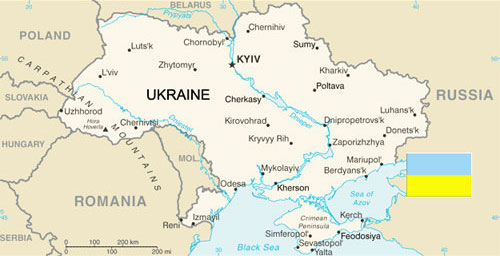Who is fighting whom in Ukraine – and why

(opendemocracy.net – Valery Kalnysh – February 4, 2014)
Valery Kalnysh is editor of the Kommersant Ukraina newspaper
The Maidan protests, which started over two months ago, have drawn a very clear line between the political parties. At future elections, voters will ask their candidates, ‘What did you do during Maidan?’ How might the politicians reply?
The Ukrainian parliament or Verkhovna Rada has 450 deputies. Half of them are elected from party lists (where voters elect candidates from names on a list and the party decides the order of preference i.e. who is most likely to be elected) and the other half in single seat constituencies. A draft law has to have 226 votes to pass. There are five parliamentary parties: the Party of Regions (202 MPs as at the time of writing), Batkyvschyna (90 MPs), Ukrainian Democratic Alliance for Reform or UDAR (42 MPs), Svoboda (36 MPs), Communist Party (32 MPs) and small non-affiliated parties have 43 MPs between them.
The government
The current ruling party is the Party of Regions (PoR). Its honorary leader is President Viktor Yanukovych and its Chairman, Mykola Azarov, was until very recently Prime Minister. One of Azarov’s deputies, Volodymyr Rybak, is the Acting Speaker of the Parliament. Many card-carrying members have government posts: Foreign Affairs Minister Leonid Kozhara is another Deputy Chairman of the party.
The power vertical is thus made up of Yanukovych supporters. The government has always maintained, and still does, that this vertical gives it a clear advantage in the work it has to do. Many people still remember the internal conflicts within the ‘Orange’ team, when President Viktor Yushchenko was unable to find common ground with Prime Minister Yulia Tymoshenko. We should not forget that it was Yushchenko, not Yanukovych, who instructed the National Security and Defence Council to investigate the circumstances in which Ukraine signed gas deals with Russia in 2009. And it was during his presidency that Ukraine’s Security Services started collecting evidence against Tymoshenko, though it was Yanukovych who subsequently used this evidence to send Tymoshenko to prison for seven years.
Logically, all these attacks on the power vertical by its own members should represent a threat to its existence, and this is indeed the case: Maidan’s main demand is that Viktor Yanukovych should resign as head of state, and snap presidential elections called.
Shortly before his resignation, Mykola Azarov tried to persuade Ukrainians that ‘people throughout practically the whole country support government policy and the President.’ His explanation for this was that ‘people realise that the initial reason for the protest, i.e. EU integration, has now receded into the background and is no longer of prime importance. The bullyboys are not interested in European integration.’
Communists and others
Ukrainian Communists have always made their opposition to PoR very clear. Strangely, however, whenever the ‘Regionals’ needed support for legislative initiatives, it was always the Communists who came to their aid. The last time this happened was in January, when laws were being passed which significantly restricted citizens’ rights, in particular freedom of speech and assembly. These laws were voted in by 183 PoR deputies, 32 Communists and 19 from the non-affiliated parties (they have since been repealed).
The Communists explain the divergence between their words (they are always supposedly acting on behalf of the people and against the oligarchs) and deeds (their support for the ruling party, which has a larger concentration of oligarchs than any other party) as a desire to take the best course of action for the prevailing conditions. For instance, although they condemned the government’s substandard 2014 budget, they still voted for it, because ‘if there were no budget, it would be even worse for the Ukrainian people.’
The government also enjoys the support of some of the MPs elected from single seat constituencies, many of whom won their seats in parliament with the covert, and sometimes even quite overt, support of PoR. But these MPs tend to vote on an ad hoc basis, and their decisions have little to do with the party line.
The opposition
The oldest opposition party is Batkyvschyna (Ukrainian for ‘fatherland’) whose leader for ever and a day has been Yulia Tymoshenko (currently serving a prison sentence). In 2012 the party merged with the Party for Change led by Arseniy Yatsenyuk. It’s hard to say which side gained more from this merger: Yatsenyuk managed to get his people into Parliament, and Batkyvschyna acquired a leader who re-injected some life into the flagging battle with the regime. And Tymoshenko still has considerable influence within the party: she writes regular letters to her supporters and her defence lawyer Serhiy Vlasenko makes sure they are delivered.
Tymoshenko’s position does not always coincide with Yatsenyuk’s. For instance, when the opposition were being offered government posts, Arseniy Yatsenyuk insisted on full Cabinet membership, rather than a few ministerial portfolios. Tymoshenko’s reaction, on the other hand, was, ‘I appeal to the leaders of the opposition not to accept any of the humiliating conditions being offered by the government.’
Another somewhat sensitive element in the relationship between the two concerns the rule that under Ukrainian law a convicted felon who has not completed his or her sentence is not entitled to stand as a presidential candidate. This, however, did not prevent the 2013 party conference putting forward Yulia Tymoshenko as a candidate for the presidency in 2015. Time is moving on and she has not been released, but there is still no other candidate, which is a source of tension within the opposition.
UDAR – the Ukrainian Democratic Alliance for Reform (the initials spell ‘punch’ in Ukrainian) – whose leader is world-famous boxer Vitaly Klitschko, and Svoboda (Ukrainian for ‘freedom’), led by Oleh Tyahnybok, were elected only in the most recent parliamentary election. What the parties actually stand for is only clear in the case of Svoboda. This is a nationalist party, which sees Ukraine’s future as an independent state. Just before the 2011 presidential election, I interviewed Tyahnybok, who was standing as a candidate. Then, as now, his stance was that he and his party ‘are trying gradually to implement our programme, which is to defend Ukrainians.’ They are in favour of Ukraine once more becoming a nuclear power, of re-introducing information about ethnicity in passports, and the death penalty. ‘We are actively promoting the return of the death penalty for particularly heinous crimes against the nation, the state or individuals’, Tyahnybok told me. ‘We see the death penalty as one of the most effective ways of dealing with corruption.’
UDAR’s leader Vitali Klitschko has as yet little political authority. At meetings of party leaders, others (such as Oleksandr Yefremov from PoR) start smiling when he opens his mouth to speak. The government does not see him as a serious politician, but as a puppet deftly operated by other people, who are cleverer and able to think strategically. For this reason, it is quite difficult to understand which vision of Ukraine he is advocating. His calls to action are on the whole fairly general: life in Ukraine should be honourable and fair; violence should not be used on civilians; the economy should work for the benefit of the whole population. But perhaps it’s just that – no confused and impractical plans for rebuilding Ukraine – as well as his tonguetiedness, that make him a politician who is equally popular in the west and the east of the country.
All three opposition parties agree on one point: the government has to go and Yanukovych has to resign as president. Yatsenyuk, Klitschko and Tyahnybok are united on this and prepared, in public at least, to forgive each other a good deal. They are ready, for instance, not to notice, or not to give too much significance to, the demolition of the statue of Lenin in Kyiv (in private Klitschko was categorically opposed to this Svoboda action). They have a common goal and they must move towards it.
The people
Maidan has really divided Ukraine. The values of the protesters in Kyiv are not always, and not wholly, shared by people in the (mostly Ukrainian-speaking) west and the (mostly Russian-speaking) east of the country. The latest data from the Democratic Initiatives Foundation and the Razumkov Centre show that 50% of Ukrainians support Euromaidan as a phenomenon; 42% do not. In the west of the country 80% are in support and 7% are not; in the east, the figures are 30% and 65% respectively.
According to this research, ‘there is overall majority support for democracy as the most desirable form of government’, with 51% in favour. 20.5% of Ukrainians would prefer ‘an authoritarian government’, and 12% are ‘don’t knows.’ Support for democracy varies from region to region: it’s strongest in the west (77%), roughly the same in the south (56%) and centre (52%), and considerably lower in the east (36%). That said, in the eastern Donetsk, Lugansk and Kharkiv regions, ‘support for a democratic or authoritarian regime is more or less even; the Donetsk region, however, has more people (34%) who have no particular preference either way.’
This research was carried out at the end of December 2013, but the public has become radicalised since then. The recent clashes at Hrushevsky street, the kidnapping of Maidan activists and the mass burning of Automaidan cars have pushed the so-called ‘Right Sector’ to the front of the active protest. Maidan protesters minded to take a much tougher line have united to defend the justice of their cause not only with words, but with Molotov cocktails too. On 24 January, the leader of the ‘Right Sector’, Dmytro Yarosh published his ‘Algorithm of Revolution’: one of its eleven points is ‘We carry out partisan raids in Kyiv; the earth must burn beneath the feet of the occupiers. We shall hunt down the armed gangs of the Berkut, ‘titushki’, PoR MPs and Communists.’
In response to the actions of the ‘Right Sector’, the ‘Ukrainian Front’ has been set up, under the aegis of the PoR. Its ideologues are Kharkiv governor Mykhailo Dobkin and mayor Hennadiy Kernes. ‘The Front will purge and cleanse the Ukrainian land from anyone who has come here as an occupier,’ said Dobkin, obviously referring to people from the western regions of the country. ‘The handful of dyed in the wool nationalists who have come down from Mount Hoverla [the highest point in Ukraine, on the border between the Transcarpathian and Ivano-Frankivsk regions] are armed not only with a script, but also with truncheons. They have decided that they are the true Ukrainians who will create a national idea and proclaim it on behalf of us all. Our patience has its limits. When we see that all the peaceful routes to re-establishing order in our country have been exhausted, we will start to get tough.’
There is still a very strong wish to believe that ‘Right Sector’ and ‘Ukrainian Front’ are at the extremes of one and the same movement, that the Ukrainian government and the opposition will have enough wisdom and strength (and the chance) not to let the country slide into civil war. When a compromise has been reached, everyone who is asked what they did during Maidan, or why they were against it, will answer ‘I was fighting for Ukraine.’ And it will be true.
Article also appeared at http://www.opendemocracy.net/od-russia/valery-kalnysh/whoisfightingwhomnukraineandwhy bearing the following notice:
 This article is published under a Creative Commons Attribution-NonCommercial 3.0 licence. If you have any queries about republishing please contact us. Please check individual images for licensing details.
This article is published under a Creative Commons Attribution-NonCommercial 3.0 licence. If you have any queries about republishing please contact us. Please check individual images for licensing details.

